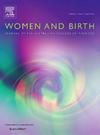Maternal satisfaction with outpatient balloon catheter versus inpatient prostaglandin induction of labour: A randomised controlled trial in Aotearoa New Zealand
IF 4.1
2区 医学
Q1 NURSING
引用次数: 0
Abstract
Background
Little is known about women’s satisfaction with induction of labour experiences in the context of randomised controlled trials, specifically those evaluating outpatient balloon catheter vs inpatient vaginal prostaglandins.
Objective
To determine satisfaction levels for women having induction of labour with outpatient balloon vs inpatient-prostaglandin.
Study design
Online survey of maternal satisfaction with induction of labour at term within a multi-centre randomised controlled trial in Aotearoa-New Zealand comparing outpatient-balloon with inpatient prostaglandin induction. Outcomes were measured at four to eight weeks after birth. Analysis was chi-square and t-test for descriptive statistics and thematic analysis for free-text data.
Results
There were 821 participants. For women in the outpatient-balloon group, insertion pain was greater than expected compared to those in the inpatient-prostaglandin group (p = 0.01), however, overall pain was less than expected (p = 0.009). Women in the outpatient-balloon group were less tired at transfer to birthing suite (p < 0.001) and more likely to choose a future induction (p < 0.01) and by the same method (p < .0001). Themes from the free-text data provided by 514 participants were (1) Care and Support; (2) Pain and Discomfort; (3) Sleep and Rest, highlighting novel explanatory evidence of better pre-labour care, less pain and more sleep in the outpatient-balloon group. Information and choice on the induction process were lacking for both groups.
Conclusions
This study demonstrated greater satisfaction among women having outpatient-balloon induction of labour related to more pre-labour support at home and less pain and tiredness during labour. We encourage maternity hospitals to routinely offer outpatient-balloon induction of labour.
产妇满意度门诊球囊导管与住院前列腺素引产:新西兰奥特罗阿的一项随机对照试验
背景:在随机对照试验的背景下,妇女对引产经验的满意度知之甚少,特别是那些评估门诊气囊导管与住院阴道前列腺素的试验。目的比较门诊用球囊引产与住院用前列腺素引产对产妇的满意度。研究设计:在新西兰奥特罗瓦进行的一项多中心随机对照试验中,在线调查了产妇对足月引产的满意度,比较了门诊患者球囊引产和住院患者前列腺素引产。结果在出生后4到8周进行测量。描述性统计采用卡方检验和t检验,自由文本数据采用专题分析。结果共821名参与者。与住院前列腺素组相比,门诊气囊组的女性插入疼痛大于预期(p = 0.01),然而,总体疼痛小于预期(p = 0.009)。门诊气囊组的妇女在转移到产房时较少疲劳(p <; 0.001),更有可能选择未来的引产(p <; 0.01),并采用相同的方法(p <; .0001)。514名参与者提供的自由文本数据的主题是(1)关心和支持;(2)疼痛和不适;(3)睡眠和休息,突出了门诊气囊组更好的产前护理,更少的疼痛和更多的睡眠的新解释证据。两组都缺乏诱导过程的信息和选择。结论门诊气囊引产妇女满意度较高,分娩前在家提供更多支持,分娩过程中疼痛和疲劳减少。我们鼓励妇产医院定期提供门诊气囊引产。
本文章由计算机程序翻译,如有差异,请以英文原文为准。
求助全文
约1分钟内获得全文
求助全文
来源期刊

Women and Birth
NURSING-OBSTETRICS & GYNECOLOGY
CiteScore
7.20
自引率
13.20%
发文量
371
审稿时长
27 days
期刊介绍:
Women and Birth is the official journal of the Australian College of Midwives (ACM). It is a midwifery journal that publishes on all matters that affect women and birth, from pre-conceptual counselling, through pregnancy, birth, and the first six weeks postnatal. All papers accepted will draw from and contribute to the relevant contemporary research, policy and/or theoretical literature. We seek research papers, quality assurances papers (with ethical approval) discussion papers, clinical practice papers, case studies and original literature reviews.
Our women-centred focus is inclusive of the family, fetus and newborn, both well and sick, and covers both healthy and complex pregnancies and births. The journal seeks papers that take a woman-centred focus on maternity services, epidemiology, primary health care, reproductive psycho/physiology, midwifery practice, theory, research, education, management and leadership. We also seek relevant papers on maternal mental health and neonatal well-being, natural and complementary therapies, local, national and international policy, management, politics, economics and societal and cultural issues as they affect childbearing women and their families. Topics may include, where appropriate, neonatal care, child and family health, women’s health, related to pregnancy, birth and the postpartum, including lactation. Interprofessional papers relevant to midwifery are welcome. Articles are double blind peer-reviewed, primarily by experts in the field of the submitted work.
 求助内容:
求助内容: 应助结果提醒方式:
应助结果提醒方式:


